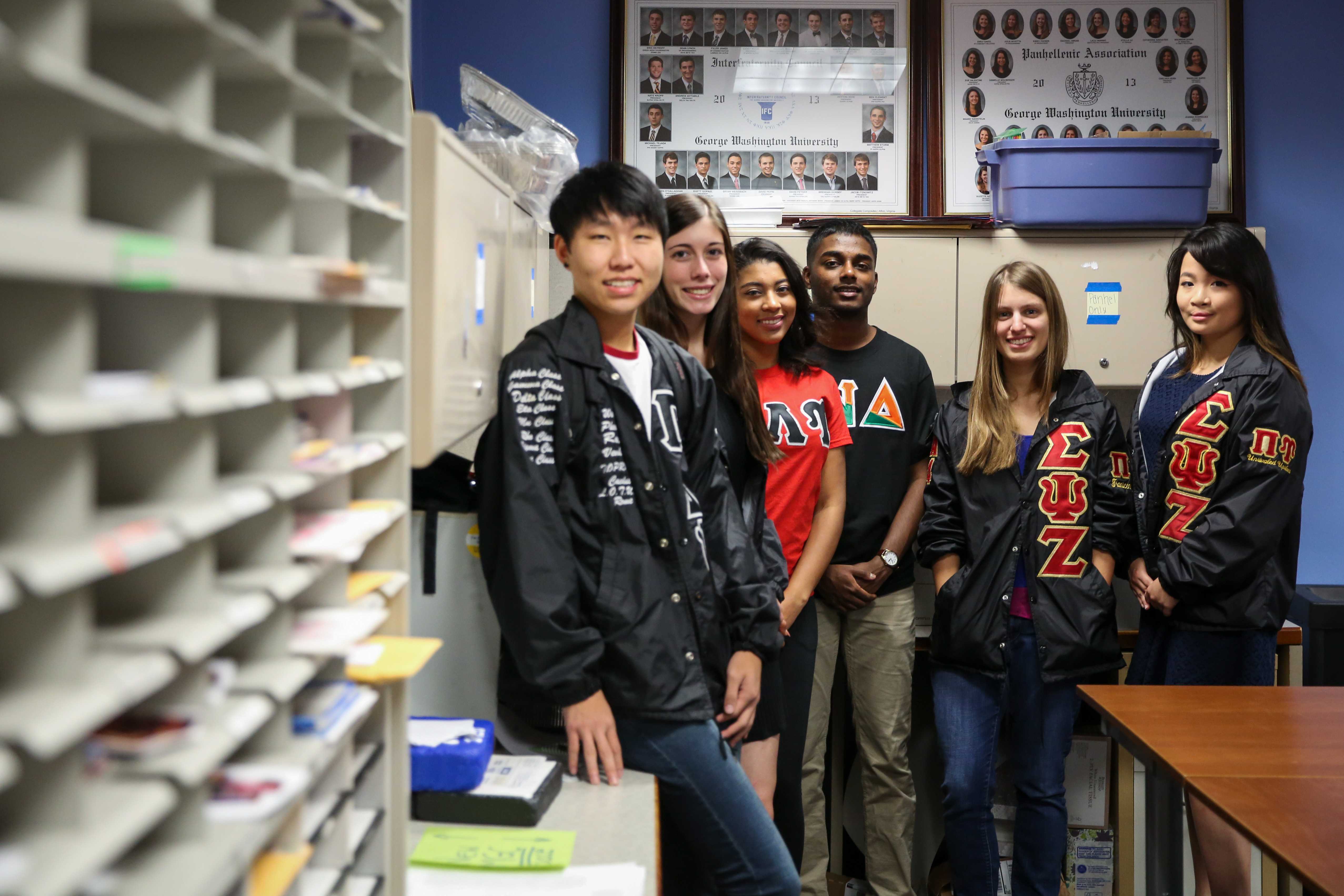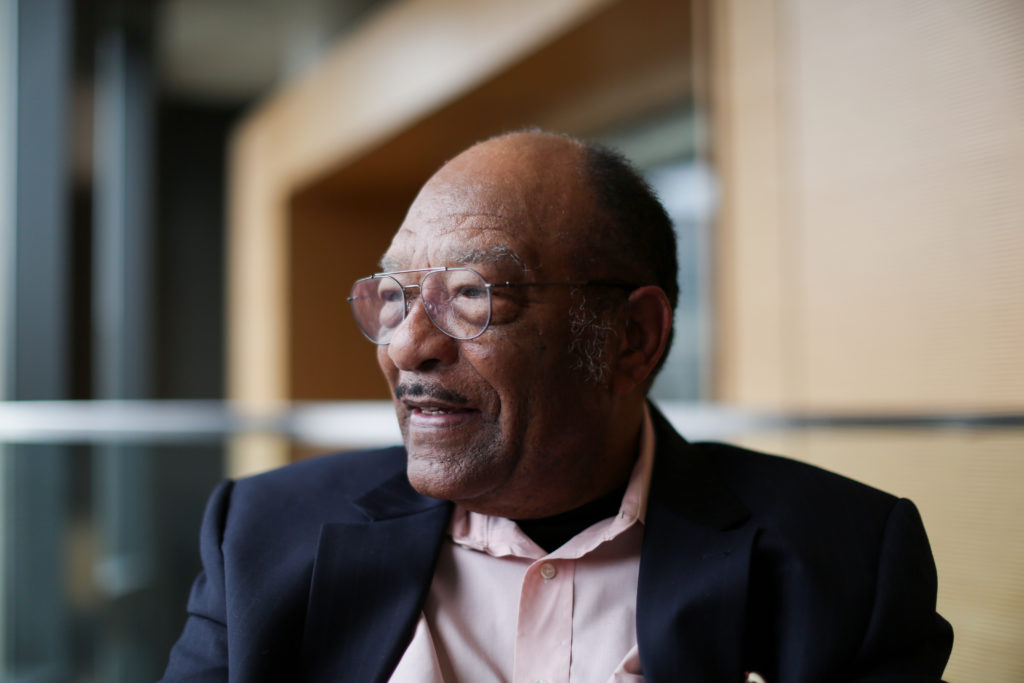Updated: Feb. 25, 2019 at 11:01 a.m.
As Black History Month draws to a close, The Hatchet sifted through its own archives and University historical archives to take an in-depth look at black history at GW.
The following timeline breaks down major events on campus over several decades of change at the University as both accomplishments and challenges pushed GW through racial progress.
1938: Former University President Cloyd Heck Marvin said in 1938 that “students of any race or color perform their best” when they are in a “homogenous group, and the University, in its tradition and social environment, has long preserved this policy,” The Hatchet reported in 2003.
[gwh_image id=”1081168″ credit=”Hatchet Archives” align=”right” size=”embedded-img”]Former University President Cloyd Heck Marvin[/gwh_image]
“The George Washington University does not register colored students,” he said.
October 1946: A group of black individuals was denied admission to the first commercial performance at Lisner Auditorium.
Ingrid Bergman – who was set to star in “Joan of Lorraine,” the first show at the venue – publicly denounced GW’s segregation. The event sparked a series of protests throughout the show’s run, prompting the National Symphony Orchestra to cancel its performances scheduled at Lisner Auditorium the following month and the Dramatists Guild of America to boycott the venue.
In the Nov. 14, 1946 issue of The Hatchet, Vincent DeAngelis, a former manager of Lisner Auditorium, said the system of segregation was “no different from the dual system at the other Washington theaters, or the restaurants, or the schools generally.”
February 1947: The Board of Trustees voted to admit people of color to commercial performances in Lisner Auditorium, according to the Feb. 18, 1947 edition of The Hatchet. After “Joan of Lorraine” closed, Lisner Auditorium was used exclusively for University events and two children’s productions, but the vote allowed the auditorium to resume commercial uses.
“When opened for lease for such purposes, the University will impose no restrictions on attendance,” the Board of Trustees said.
May 1954: After the Supreme Court’s Brown v. Board of Education ruling denounced “separate but equal” practices, the University was fully integrated.
1963: Freshman Rocky Wright became the first black athlete at GW as a member of the men’s basketball team, but he did not receive a scholarship, according to the March 19, 1963 issue of The Hatchet.
March 1963: Norman Neverson was the first black student to receive an athletic scholarship from the University when he was recruited for the football team as a lineman.
“Neverson has proved to our scouts that he can play football, and that is what we are interested in,” former head football coach Jim Camp said in an interview with The Hatchet in 1963.
Neverson said in a recent interview that while he was enrolled at GW there were two different Americas: “We had a black America and a white America.”
“There was no socialization between blacks and whites in this city until 1963,” Neverson said. “We changed that paradigm because in 1963, the year of the March on Washington – when Dr. King made his great pronouncement – we were at the Lincoln Memorial, all of us were as one team. Not football players, but students.”
More than 50 years after being recruited by the football team, Neverson said that he is still thankful that GW afforded him the opportunity to “grow and excel.”
“Anyone who came out of D.C. in the ‘60s remembers that epic moment when this 18-year-old boy integrated GW athletics,” Neverson said. “But to me, 56 years later, I was blessed to have been in the right place at the right time.”
September 1963: Former D.C. Mayor Vincent Gray enrolled at the University and was not allowed to join the baseball team because he was black, The Hatchet reported in 2011.
[gwh_image id=”1081179″ credit=”Cherry Tree Archives” align=”left” size=”embedded-img”]Former student Vincent Gray[/gwh_image]
Gray said that the “bad situation” surrounding race on campus made him want to initially leave after his first year. But after he joined Tau Epsilon Phi – which made Gray the first black student to join a fraternity at GW – he said he found his place at the University.
“It helped me realize that as much racism as there was present on campus, there were so many people who were just good people,” he said.
Gray said while it was not easy, his experiences at GW have informed who he is today.
“It was a shaping experience for me to stay at GW and to go through, which some days they were just not pleasant at all,” he said. “It made me a better person for it in the long run. It taught me to fight racial issues.”
1964: An image in the Cherry Tree Yearbook depicts two men in blackface at a talent show. More than a dozen photos of people in blackface or Ku Klux Klan hoods were discovered by The Hatchet in February amid a national controversy surrounding racist yearbook photos.
February 1968: The Black Student Union was instituted as a student organization and hosted its first events on campus in celebration of Black History Month, according to the Feb. 13, 1968 issue of The Hatchet.
The first organizer of the Black Student Union, Peggy Cooper Cafritz, also pushed for sororities to become integrated on campus by making the student body aware of problems in the black community.
“We’d like to see the sororities fully integrated or kicked off campus by June,” Cooper Cafritz said in an interview with The Hatchet in 1968.
April 1968: Two hundred students, many of them white, quietly and nonviolently marched to Rice Hall with the Black Student Union to demand better educational opportunities for black students like job opportunities, increased enrollment of black students and the end of contracts with firms that did not abide by the Civil Rights Act.
September 1968: The University hired its first black professor, Jay Saunders Redding, who taught two courses dealing with “the literature and history of the black man in America,” according to the Sept. 16, 1998 issue of The Hatchet.
Redding’s hiring came four months after the Black Student Union first demanded that the administration add “black-oriented” courses to the curriculum.
September 1968: The University Human Relations Act was established at GW, barring campus organizations from discriminating membership on the basis of “race, religion or national origin,” according to the Sept. 23, 1968 edition of The Hatchet.
1969: GW enacted an Educational Opportunity Program, offering full tuition to 40 black students in the District, according to previous Hatchet reporting in 2013.
1970: Fraternities struggled to succeed on campus due to low membership and debt, according to the April 6, 1970 issue of The Hatchet. But “many people dislike fraternities because they believe frats are biased against racial and religious minorities,” The Hatchet reported. In the fall of 1969, there were 12 fraternities, but by late 1970 Greek life leaders predicted that there would be only about five.
1971: Ten sororities disbanded by 1971 because of their inability to comply with the University Human Relations Act of 1968, according to previous Hatchet reporting in 2013.
April 1975: The historically black sorority Delta Sigma Theta was established at GW, which is still an organized group on campus.
Fall 2003: Michael Tapscott was hired as the director of the Multicultural Student Services Center. Tapscott said since he took the helm in 2003, the center has grown a lot and been able to make a bigger impact on campus.
[gwh_image id=”1081178″ credit=”Hatchet File Photo” align=”right” size=”embedded-img”]Director of the Multicultural Student Services Center Michael Tapscott[/gwh_image]
“We’ve been fortunate to have a lot of opportunities to try to have an impact, to be an influencer and to be an office that people look to for a really equitable approach to problem-solving,” Tapscott said. “We emphasize community building. When problems arise, we emphasize dialogue and conversation because people don’t change just because you want them to. People change because they have a deeper understanding of differences and a deeper, deeper understanding of a perspective that is not one they share.”
February 2003: GW was named one of the top 25 best colleges for black students, according to Black Enterprise magazine. The University was ranked No. 24 based on a survey of 1,855 black professionals in higher education.
November 2008: The Panhellenic Association and Interfraternity Council included the Multicultural Greek Council in its annual Greek Week for the first time.
“This is the best Greek Week yet because we’re all included,” former student and member of Pi Beta Phi Shannon Reed said in an interview with The Hatchet in 2008. “We should be inclusive and not exclusive.”
November 2008: Hundreds of students stood outside the White House to celebrate the victory of former President Barack Obama, the first black president.
April 2010: Former University President Steven Knapp created the Council on Diversity and Inclusion to make GW more diverse.
“GW has a long history of equal opportunity and of a strong commitment to diversity,” Knapp said in an interview with The Hatchet in 2010. “This is not only the right thing to do; as the world grows smaller and the make-up of the U.S. population changes, we can only maintain our competitiveness and academic excellence if we reach out effectively to people of all backgrounds.”
February 2011: The University named Terri Harris Reed as its first vice provost for diversity and inclusion as the University attempted to attract students and employers from more diverse backgrounds and redefine the MSSC.
“I was a first-generation college student and a person of color at traditionally white institutions, as both a student and employer,” she said in an interview with The Hatchet in 2011. “I feel like I have a handle on both sides of the issue, experiencing being feeling not included and trying to move an institution forward.”
September 2012: The University’s multicultural office planned a mandatory diversity training program for members of all student organizations.
February 2015: Nine black officials were named as top-level administrators since 2010 amid a University wide push to advance diversity efforts.
October 2016: The Multicultural Greek Council added four new chapters in a year – including the historically black fraternities Phi Beta Sigma and Alpha Phi Alpha – making a total of 15 multicultural chapters on campus.

Hatchet File Photo
Members of the Multicultural Greek Council’s executive board in 2016 Eugene Lee, Elena Hoffman, Jamila Vizcaino, Elmer Rajah, Clare Lewis and Tiffany Chai
October 2016: The Multicultural Student Services Center launched “Diversity Dialogues,” which brought groups of eight to nine students to discuss social justice, identity, race and ethnicity, in hopes of strengthening the conversation about diversity and inclusion on campus.
“In response to the black student community’s recent callings for healing, unity, reconciliation and peaceful dialogue, ramping up this training approach is the right thing to do, and it is good for community building,” Tapscott said in an interview with The Hatchet in 2016.
September 2017: Brittany Lewis, a doctoral student in the history department, was crowned the 49th Miss Black America.
“I never considered myself a pageant girl, but Miss Black America was part of a larger narrative I was interested in,” Lewis said in an interview with The Hatchet in 2017.
October 2017: The history department announced it would offer a Slavery, Segregation and GWU course for the first time, allowing history majors to conduct research into how slavery and segregationist policies have affected the University.
Katrin Schultheiss, the chair of the history department, said the course was created to delve deeper into GW’s history.
“You have to understand the past of an institution to understand where it is now, and there’s been a lot of talk about these kinds of connections that have long been buried,” Schultheiss said in an interview with The Hatchet in 2017.
February 2018: A racist Snapchat post emerged depicting two members of Alpha Phi, one of whom is holding an empty banana peel, with the caption “Izzy: ‘I’m 1/16 black.’”
Over the year after the post, the University and the student body enacted a slew of changes.
The post sparked a few widespread conversations about race on campus.
Officials responded with a 12-page report outlining a nine-point plan to improve diversity and inclusion at GW through efforts like hiring a diversity and inclusion training director, hosting a Race in America speaker series and requiring diversity training for freshmen.
September 2018: Student Association leaders took the first steps to shape the SA’s diversity and inclusion assembly. The group, including multicultural student leaders and SA senators, was created to voice concerns about campuswide diversity issues.
[gwh_image id=”1081167″ credit=”File Photo by Donna Armstrong | Contributing Photo Editor” align=”right” size=”embedded-img”]SA Sen. AJ Link, Law-G[/gwh_image]
SA Sen. AJ Link, Law-G, the chairman of the group, said organizations like the diversity and inclusion assembly are important to help underrepresented and marginalized students address issues and concerns that can be overlooked by the bigger student population or by administrators.
“I think that education is one of the best ways to make places more inclusive,” Link said. “Once you learn about your neighbor, you can kind of include them more and make sure that you’re making them comfortable in your environment.”
Since the start of the assembly in September, Link said the group successfully hosted four to five listening sessions and got about 15 student leaders involved along with about 15 SA senators. But Link said the group is still finding its way because the assembly is still brand new.
“I am proud of the fact that the students who are part of DIA are passionate students and they care about diversity and inclusion work and they take it seriously and they take it to heart,” he said. “But I am a little bit frustrated that the larger campus doesn’t seem to care as much.”
Fall 2018: Jordan West became the inaugural diversity and inclusion education director. Since she was hired, West facilitated hundreds of conversations with students, faculty and officials on campus to help them combat biases, The Hatchet reported in January.
2018: The National Pan-Hellenic Council, a black Greek-letter organization, returned to campus last semester after leaving for more than a decade. The council unifies GW’s six historically black sororities and fraternities under one umbrella organization.
Simone Hunter-Hobson, the president of the council and a member of Delta Sigma Theta, helped officially restart the council this academic year.
“The council just allows all the black letter organizations to unite and have a common goal,” Hobson said in an interview with The Hatchet in January. “The different chapters on campus can come together and be able to do great things for our organizations, our community.”
Katherine Abughazaleh, Kathryn Kline and Gabrielle Kossuth contributed reporting.
This post was updated to reflect the following correction:
The Hatchet incorrectly reported in a photo caption the year that Norman Neverson received an athletic scholarship. We regret this error.




